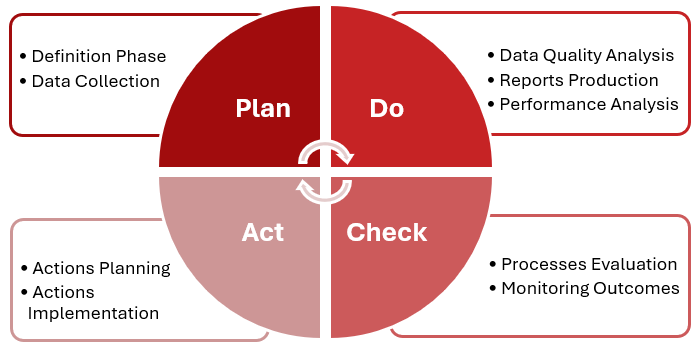Train Performance Management entails the continuous process of monitoring and improving trains’ performance by defining and measuring performance indicators and setting goals that are aligned with the railway sector’s and Members’ strategic targets. The main activities include reviewing and assessing related processes and developing relevant performance management guidelines and reports.
The RNE train performance management processes follow a continuous improvement loop and is governed by the Plan-Do-Check-Act management cycle.
Plan Stage
This stage aims to set the principles and collect the data that will be the basis for the following stages.
The definition phase is considering a wide range of topics as follows:
- Market and stakeholders need.
- Compliance with International legislation.
- Data availability and confidentiality.
- Definition of indicators and KPIs.
- Sample of trains to be monitored.
- Frequency of monitoring.
- Reports’ purpose, content and layout.
The data process starts at the IM national level, where all train runs are monitored and recorded in the IM’s domestic system and sent to TIS in real time. TIS processes all the received messages and stores the consolidated information in a data warehouse. Based on the stored data, simple and user-friendly train performance monitoring reports and dashboards are generated and can be accessed by the users on RNE public dashboards (aka live data) or via the RNE Reporting Tool.
Do Stage
At “Do Stage”, the goal is in the regular investigation of train performance through the processing and analysis of the collected data. This processing and analysis consist of three different steps:
- The first step focuses on data quality analysis to ensure the accuracy of the data collected and the reliability of produced reports.
- The next step is to process the data from the collection phase and produce reports to ensure that the information is useful and understandable.
- In the third stage, the reports generated in the previous step is used for an in-depth study comparing the current level of performance to the eventual pre-defined targets and, if non-compliance with the targets, determining the causes for poor performance.
The current indicators available in the RNE Train Performance Management reports are based on the following information:
Check Stage
The Check Stage evaluates the findings from the Do Stage, ensuring accuracy and identifying areas for improvement.
- Verify Analysis – Review reports for accuracy, validate trends, and cross-check data.
- Stakeholder Feedback – Share findings with IMs, RUs, and other stakeholders to gather insights.
- Performance Compliance Check – Compare actual performance against targets and assess progress.
- Identify Gaps – Highlight persistent issues and areas needing further attention.
- Decision-Making – Determine next steps, define priorities, and prepare for corrective actions in the Act Stage.
Act Stage
This stage defines the measures to be implemented to improve trains performance, trains performance monitoring and data collection. Afterwards the implementation of the actions guarantees the continuous improvement of the system.
To perform all tasks and guarantee reliable and harmonized performance monitoring, RNE provides a platform for cooperation and coordination related to Train Performance Management in two main groups.
- The Data Quality Expert Group constantly monitors TIS data quality, proposes measures for its improvement and streamlines the data quality management process.
- The Performance Management Working Group is a platform for networking and experience sharing among RNE Members. It defines train performance management and reporting guidelines and processes, prepares stakeholders-oriented dashboards and reports (IM, RFC, RU and Terminal) and has the role of change control board for reporting and the technical architecture of reporting tools.
Key Benefits of RNE Train Performance Monitoring reports are:
- Providing customised and oriented reports/datasets.
- Coordinated railway data presentation with restricted access to sensitive information.
- Data quality assessment and data deficiency identification.
- Advanced analytics to identify bottleneck areas, measure system resilience and plan corrective actions.
- Insight into business facts by providing train performance KPIs and statistics relevant to different stakeholders.
- Increase of transparency of international railway traffic within the European network.
- Encouraging the improvement of the overall railway efficiency.


